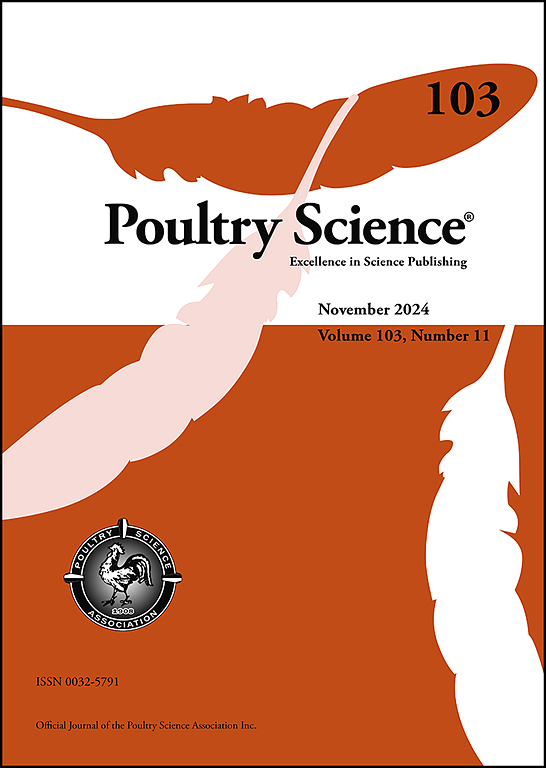研究说明:一项试验性研究,比较了自由放养系统下的白莱霍恩和伊萨布朗品种的生产性能、蛋质量和牧场特性
IF 3.8
1区 农林科学
Q1 AGRICULTURE, DAIRY & ANIMAL SCIENCE
引用次数: 0
摘要
本试验旨在研究伊沙布朗(IB)和白来客霍恩(WL)蛋鸡的牧草生长、植物组成(BC)变化以及牧草消耗对蛋鸡产蛋性能和蛋品质的影响。试验选用18周龄母鸡30只,IB母鸡15只,WL母鸡15只,均经过2周的预试期。母鸡随机分为3个田间重复,每个重复为20 m²的牧场地块,每个地块5只鸡。每只母鸡饲喂均衡的精料饲粮,每只母鸡每天提供120 g。每隔10 d监测牧草消耗和植物偏好。每个监测期结束后,对整个草场进行轮作。测定牧草消耗量、牧草质量和生物量。在每10 d的试验开始和结束时分别评价鸡蛋的外部品质和内部品质。与WL母鸡相比,褐母鸡消耗的牧草明显更多,平均每天消耗43.9 g,而每只母鸡每天消耗28.5 g (P <;0.0001)。放牧后的草地高度,WL组(10.9 cm)比IB组(6.7 cm)高4.31 cm。此外,放牧前后牧草的植物组成表明,阔叶植物明显优于豆科植物,两种基因型均对豆科植物优于禾本科植物。蛋品质量结果表明,IB比WL的蛋重(62.01比58.96 g)、蛋宽(44.18比43.23 mm)、蛋形指数(78.96比77.65%)、蛋黄颜色(10.13比8.97单位)、蛋黄指数(46.02比45.46%)更高。相比之下,WL比IB在蛋壳率(9.87比9.71%)、蛋白指数(13.27比10.89%)和哈夫单位(91.21比86.11)上都更高。基因型间卵长无差异。这些发现为了解不同基因型蛋鸡的放牧行为和牧草偏好及其对牧场管理和产蛋系统的潜在影响提供了有价值的见解。本文章由计算机程序翻译,如有差异,请以英文原文为准。
Research Note: A pilot study comparing White Leghorn and Isa Brown breeds under a free-range system on performance, egg quality and pasture characteristics
The aim of this study was to assess pasture growth, changes in botanical composition (BC), and the effects of pasture consumption on laying performance and egg quality in Isa Brown (IB) and White Leghorn (WL) hens. A total of thirty 18-week-old hens: 15 IB and 15 WL were used in this experiment which began after a two-week adaptation period. The hens were randomly assigned to three field replicates, each consisting of a 20 m² pasture plot with 5 hens per plot. Each hen was fed a balanced concentrate diet providing 120 g per hen per day. Pasture consumption and plant preference were monitored at 10-day intervals. After each monitoring period, the entire pasture plot was rotated. Pasture consumption, herbage mass and BC were assessed. External and internal egg quality were evaluated at the beginning and at the end of each 10-day period. Isa Brown hens consumed significantly more pasture compared to WL hens, with a mean consumption of 43.9 g per day versus 28.5 g per hen per day, respectively (P < 0.0001). The post-grazing pasture height was 4.31 cm higher in plots grazed by WL hens (10.9 cm) compared to those grazed by IB (6.7 cm). Moreover, botanical composition of the pasture before and after grazing indicated a clear preference for broadleaf species over legumes, and legumes were preferred over grass species by both genotypes. Egg quality results showed that IB vs. WL had greater egg weight (62.01 vs. 58.96 g), egg width (44.18 vs. 43.23 mm), egg shape index (78.96 vs. 77.65%), yolk color (10.13 vs. 8.97 units), yolk index (46.02 vs. 45.46%). In contrast, WL vs. IB was greater in eggshell percentage (9.87 vs. 9.71%), albumen index (13.27 vs. 10.89%) and haugh units (91.21 vs. 86.11). No difference for egg length were found between genotypes. These findings provide valuable insights into the grazing behavior and pasture preferences of different laying hen genotypes, as well as their potential impacts on pasture management and egg production systems.
求助全文
通过发布文献求助,成功后即可免费获取论文全文。
去求助
来源期刊

Poultry Science
农林科学-奶制品与动物科学
CiteScore
7.60
自引率
15.90%
发文量
0
审稿时长
94 days
期刊介绍:
First self-published in 1921, Poultry Science is an internationally renowned monthly journal, known as the authoritative source for a broad range of poultry information and high-caliber research. The journal plays a pivotal role in the dissemination of preeminent poultry-related knowledge across all disciplines. As of January 2020, Poultry Science will become an Open Access journal with no subscription charges, meaning authors who publish here can make their research immediately, permanently, and freely accessible worldwide while retaining copyright to their work. Papers submitted for publication after October 1, 2019 will be published as Open Access papers.
An international journal, Poultry Science publishes original papers, research notes, symposium papers, and reviews of basic science as applied to poultry. This authoritative source of poultry information is consistently ranked by ISI Impact Factor as one of the top 10 agriculture, dairy and animal science journals to deliver high-caliber research. Currently it is the highest-ranked (by Impact Factor and Eigenfactor) journal dedicated to publishing poultry research. Subject areas include breeding, genetics, education, production, management, environment, health, behavior, welfare, immunology, molecular biology, metabolism, nutrition, physiology, reproduction, processing, and products.
 求助内容:
求助内容: 应助结果提醒方式:
应助结果提醒方式:


